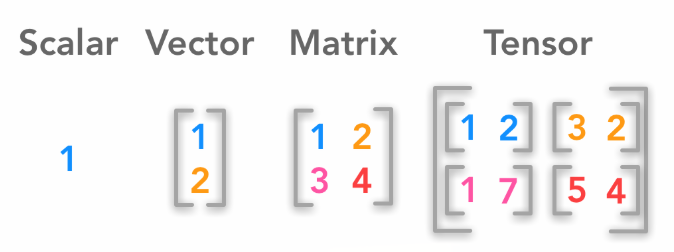🔥알림🔥
① 테디노트 유튜브 -
구경하러 가기!
② LangChain 한국어 튜토리얼
바로가기 👀
③ 랭체인 노트 무료 전자책(wikidocs)
바로가기 🙌
④ RAG 비법노트 LangChain 강의오픈
바로가기 🙌
⑤ 서울대 PyTorch 딥러닝 강의
바로가기 🙌
[PyTorch] numpy로부터 텐서 변환(copying과 sharing의 차이)
이번 포스팅에서는 Tensor의 기본 특징과 PyTorch에서 정의한 Tensor타입, PyTorch에서 numpy array를 tensor 변환시 3가지 함수 from_numpy(), as_tensor(), tensor()의 사용법과 그 차이점에 대하여 알아보도록 하겠습니다.
스칼라, 벡터, 메트릭스, 텐서
아래의 그림에서 잘 설명되어 있듯이
-
단일 값은
Scalar -
1D(1차원) 데이터는
Vector -
2D(행렬) 데이터는
Matrix -
3차원 이상의 데이터는
Tensor
from IPython.display import Image
Image(url='https://mblogthumb-phinf.pstatic.net/MjAyMDA1MjVfMTM0/MDAxNTkwMzc4MTY4MDQy.iOzxIfhew8Bsto7uqNW3QYj-k9bysF775jXYLECD6bwg.uMJ87NPURvklkXF2TXFnygaSnc32erHm_mXbnKgvO24g.PNG.nabilera1/image.png?type=w800')

Tensor의 특성
-
torch.Tensor는 단일 데이터 타입(single data type)을 가집니다. -
torch.Tensor간의 연산은 같은 데이터타입일 경우에만 가능합니다. -
Numpy의 배열 연산으로 수행할 수 있는 내용도, GPU를 활용하여 빠르게 학습하려는 경우torch.Tensor로 변환할 수 있습니다.
필요한 모듈 import
# 모듈 import
import torch
import numpy as np
pytorch version 체크
print(torch.__version__)
1.10.2+cu113
Numpy로부터 Tensor 변환
-
방법1.
torch.from_numpy() -
방법2.
torch.as_tensor() -
방법3.
torch.tensor()
# 샘플 데이터 생성
arr = np.array([1, 3, 5, 7, 9])
print(arr)
print(arr.dtype)
print(type(arr))
[1 3 5 7 9] int64 <class 'numpy.ndarray'>
torch.from_numpy()는 torch.as_tensor()와 동일
torch.from_numpy() - sharing
t1 = torch.from_numpy(arr)
print(t1) # 출력
print(t1.dtype) # dtype은 데이터 타입
print(t1.type()) # type()은 텐서의 타입
print(type(t1)) # t1 변수 자체의 타입
tensor([1, 3, 5, 7, 9]) torch.int64 torch.LongTensor <class 'torch.Tensor'>
torch.as_tensor() - sharing
t2 = torch.as_tensor(arr)
print(t2) # 출력
print(t2.dtype) # dtype은 데이터 타입
print(t2.type()) # type()은 텐서의 타입
print(type(t2)) # t2 변수 자체의 타입
tensor([1, 3, 5, 7, 9]) torch.int64 torch.LongTensor <class 'torch.Tensor'>
# numpy array의 0번 index를 999로 값 변환
arr[0] = 999
# t1, t2 출력
print(f't1: {t1}')
print(f't2: {t2}')
t1: tensor([999, 3, 5, 7, 9]) t2: tensor([999, 3, 5, 7, 9])
torch.from_numpy()와 torch.as_tensor() 로 numpy array의 요소를 수정하게 되면 해당 numpy array로부터 생성된 tensor의 요소의 값이 변하는 것을 확인할 수 있습니다.
이러한 현상은 torch.from_numpy()와 torch.as_tensor() 모두 sharing 하기 때문입니다.
torch.tensor() - copying
# 샘플 데이터 초기화
arr = np.array([1, 3, 5, 7, 9])
print(arr)
print(arr.dtype)
print(type(arr))
[1 3 5 7 9] int64 <class 'numpy.ndarray'>
t3 = torch.tensor(arr)
print(t3) # 출력
print(t3.dtype) # dtype은 데이터 타입
print(t3.type()) # type()은 텐서의 타입
print(type(t3)) # t3 변수 자체의 타입
tensor([1, 3, 5, 7, 9]) torch.int64 torch.LongTensor <class 'torch.Tensor'>
# numpy array의 0번 index를 999로 값 변환
arr[0] = 999
# t3 출력
print(f't3: {t3}')
t3: tensor([1, 3, 5, 7, 9])
torch.tensor()로 numpy array를 변환시 sharing이 아닌 copying하기 때문에 원본 numpy array의 요소가 변하더라고 tensor에 영향을 끼치지 않음을 확인할 수 있습니다.
텐서의 데이터 타입
| TYPE | NAME | EQUIVALENT | TENSOR TYPE |
|---|---|---|---|
| 32-bit integer (signed) | torch.int32 | torch.int | IntTensor |
| 64-bit integer (signed) | torch.int64 | torch.long | LongTensor |
| 16-bit integer (signed) | torch.int16 | torch.short | ShortTensor |
| 32-bit floating point | torch.float32 | torch.float | FloatTensor |
| 64-bit floating point | torch.float64 | torch.double | DoubleTensor |
| 16-bit floating point | torch.float16 | torch.half | HalfTensor |
| 8-bit integer (signed) | torch.int8 | CharTensor | |
| 8-bit integer (unsigned) | torch.uint8 | ByteTensor |
댓글남기기